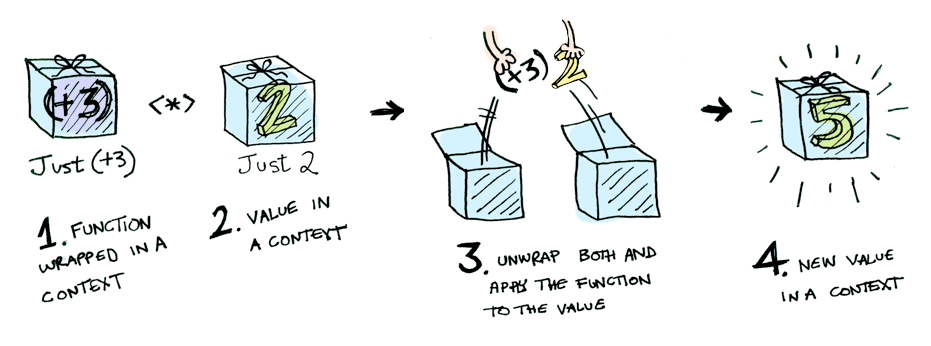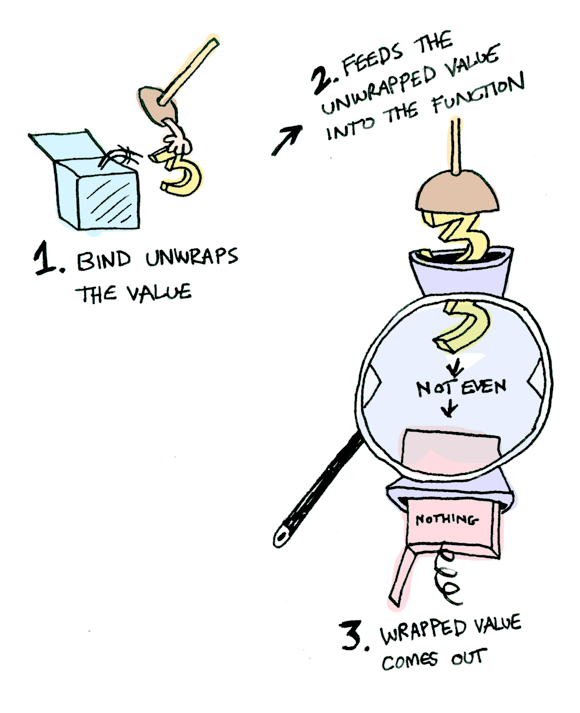
写本文的目的是为了好好理解一下Haskell中的Monads。本文基于《Learn You a Haskell for Great Good》。了解Monads,首先要了解Type Class, the Functor Type Class, Applicative Functors。咱们一个一个慢慢来。
这个比较简单,类似Java语言中的Interface。也就是说Haskell中,通过type class可以定义一种行为。所谓行为,就是接收一个东西,然后输出一个特定的东西。正如函数所做的那样。
为了创造一个Type Class,我们需要什么?
总得有个名字吧。然后得定义一个行为。这里行为怎么定义呢?行为通过函数来表示,所以定义行为就等于定义函数。既然是函数,自然有函数名,输入,输出。
编译器怎么知道你是在创建Type Class呢?关键字来了。这里有两个关键字:class和where。
来个例子:
1 | class Eq a where |
上面这个例子中,“Eq”表示该Type Class的名字。“a”是Type Parameter,表示任意一种类型,如Int, String等。之后(第二行和第三行)是定义了两个方法“==”和“/=”,使用括号将他们括起来表示他们是中缀,也就是说使用的时候要么是“5 == 4”或者是“(==) 5 4”。之后使用“::”来定义方法的输入和输出类型,两个函数都是接收两个类型为“a”的输入,输出一个Bool型。定义之后是方法的两个默认实现,由于两个实现彼此依赖,所以实现的时候只需要实现其中一个,另一个使用默认的就可以了。
来看一个实现:1
2
3
4
5
6
7
8
9--定义TrafficLight
data TrafficLight = Red | Yellow | Green
--实现Eq type class
instance Eq TrafficLight where
Red == Red = True
Yellow == Yellow = True
Green == Green = True
_ == _ = False
上例中首先定义了一个TrafficLight类,该类有三个可取值,分别为:Red, Yellow和Green。之后使用“instance”来实现“Eq” type class。也就是说给“TrafficLight”类加上“==”和“/=”这两个行为。实现中,只实现了“==”方法,根据上面的介绍,“/=”使用了默认实现。现在,我们可以看看Red == Yellow,Red == Red的值了。
至此,我们知道了Type Class是什么,如何定义,及如何使用。接下来是Functor Type Class。
首先,这是一个Type Class。是Haskell定义的众多Type Class中的一个。
我们来看看Functor Type Class的定义:
1 | class Functor f where |
首先,这个Type class的名字叫Functor。其次,它定义了一种行为,称为fmap。该行为接收一个函数及“f a”返回一个“f b”,其中a和b是接收的函数的输入和输出。“f a”和“f b”是两种类型,而“f”称为type constructor,就是说“f”接收一个类型,返回一个新的类型。举个例子:1
2
3instance Functor Maybe where
fmap f Nothing = Nothing
fmap f (Just x) = Just (f x)
我们与上面Functor的定义对应一下:Maybe就是上面的f,则fmap的定义变成了fmap :: (a->b) -> Maybe a -> Maybe b。如何应用呢?首先,由于Maybe这个type constructor实现了Functor,那么就可以在由Maybe建立的类型上使用fmap函数,该函数接收一个a->b的函数以及一个Maybe a,返回一个Maybe b。假设a->b是(+3),此处(+3)的定义为Num a => a -> a。此时,还需要另一个Maybe a类型的参数,假设为Maybe Int,则调用为fmap (+3) (Just 3),得到Just 6。针对这个例子,翻译一下fmap :: (a->b) -> Maybe a -> Maybe b,则为fmap :: (Int -> Int) -> Maybe Int -> Maybe Int。
回顾一下整个过程:
fmap :: (a->b)->f a->f b,确认f,f必须为type constructor。比如Maybe我们再来分析一下fmap干了什么事情?以fmap (+3) (Just 3)为例,fmap将(+3)这个函数应用于(Just 3)中的值3,得到结果6,然后将6转换为Maybe Int型,即Just 6。如果将fmap这个名字拆为f和map,并对f和map分别理解,会怎么样呢?
对map,它表示了一种转换。先来看看haskell中的map函数:(a -> b) -> [a] -> [b]。map函数接收一个函数以及一个数组,然后对数组中的每一个值应用该函数,然后将得到的结果放在一个数组中。简单来说就是将数组a转换为数组b。
fmap中的map,表示的也是一种转换。而f,则可以理解为一种context(域),或者是一种盒子。fmap做得事情就是将盒子中的值拿出来,应用转换函数,然后将结果再放回盒子中。此盒子有一个构造函数,输入为值,输出为盒子。比如Maybe,输入Int,则输出的盒子为Maybe Int。adit.io有一个很好的图:

我们再来看看数组:
1 | instance Functor [] where |
首先[]是一个type constructor,输入一种类型,得到另一种类型。比如输入Int,得到[Int]。fmap = map,为什么呢?正常的fmap是将f替换为[]为fmap :: (a->b)->[a]->[b],同map的定义一致。所以对[],map就是fmap。
fmap也可以这样表述:fmap接收一个函数以及一个Functor,然后输出一个新的Functor,同样一个来自adit.io的图:

Functor就是指一个通过Type Constructor得到的具体类型,而该Type Constructor实现了Functor type class。比如Just 3是根据Maybe得到的具体类型,而Maybe实现了Functor type class,则Just 3就是一个Functor。fmap (+3) (Just 3)得到Just 5,Just 3是一个Functor,Just 5是另一个Functor。
简单一点,Functor是一个Type Class,其定义了一种行为叫fmap,fmap接收一个函数和一个functor,得到一个新的functor。
Applicative 也是一个Type Class。
先不提Applicative type class。我们先来看看Functor:1
2class Functor f where
fmap :: (a->b) -> f a -> f b
Functor可以让我们这样:1
fmap (+3) (Just 3) -- the result is Just 6
如果是下面这样,输出的是什么呢?1
fmap (+) (Just 3) -- what's the result?
直接在ghci中输出的话,ghci会告诉你找不到对应的show方法。如果使用:t fmap (+) (Just 3),结果是Num a => Maybe (a -> a)。这是一种具体类型(concrete type)。考虑到Maybe的定义:1
data Maybe a = Nothing | Just a
则“Maybe (a -> a)”对应的是“Maybe (a->a) = Nothing | Just (a->a)”,因此它的一个实例为“Just (\x->x)”。
对于“(a->a)”,我们可以看看下面这段代码:1
2
3
4
5applyFunc2Value :: [(a->b)] -> a -> [b]
applyFunc2Value [] _ = []
applyFunc2Value (x:xs) y = x y : (applyFunc2Value xs y)
applyFunc2Value [(*3), (+2), (\x->x+10)] 4 -- result is: [12,6,14]
上例中的“[(a->b)]”是一个具体类型,而[]于Maybe类似,所以“Maybe (a->b)”也是一个基本类型。
1 | addMaybe :: Maybe (a->b) -> a -> Maybe b |
至此,我们知道“Maybe (a->b)”是一种具体类型,以及可以如何使用它。
Functor中的fmap接收一个函数和一个functor,得到另一个functor,比如: fmap (+3) (Just 5)会得到Just 8。如果我们想要计算Just (+3)与Just 8的值,就无法使用Functor中的fmap。而这时,applicative就派上用场了。
先看看applicative type class的定义:1
2
3class (Functor f) => Applicative f where
pure :: a -> f a
(<*>) :: f (a->b) -> f a -> f b
首先,Applicative的instance是一个Functor,即上面的f是一个Functor,也就是说有instance Functor f where ...。其次,Applicative type class定义了两个行为,也就是两个函数。一个是pure,另一个是“<*>”。pure函数接收一个参数,然后通过f来创建一个新的实例。如果f为Maybe,则pure可以为:pure x = Just x。“<*>”函数接收一个函数Functor和一个Functor,返回一个Functor。比如(Just (+3)) <*> (Just5)得到Just 8。这样就可以计算上述的Just (+3)与Just 8的值了。
按照盒子的比喻,<\*>是将第一个盒子中的函数拿出来,应用到第二个盒子中的值,然后将结果放回盒子中。这里参数中的两个盒子和返回值的盒子都是一样的。adit.io中的图:

先来看一个例子:1
2
3
4
5
6
7-- Maybe 实现Applicative
instance Applicative Maybe where
pure = Just
Nothing <*> _ = Nothing
(Just f) <*> something = fmap f something
pure (+3) <*> Just 10
除了上面的用法,我们还可以:1
pure (+) <*> Just 3 <*> Just 5
这就是pure f <*> x <*> y...,根据定义有:pure f <*> x = fmap f x,所以pure f <*> x <*> y可以写成fmap f x <*> y,在Control.Appicative中,定义了:1
2(<$>) :: (Functor f) => (a->b) -> f b -> f b
f <$> x = fmap f x
所以fmap f x <*> y可以写成f <$> x <*> y,比如:(+) <$> Just 3 <*> Just 5即为fmap (+) (Just 3) <*> Just 8。
对于[],有:1
2
3
4
5
6
7
8instance Applicative [] where
pure x = [x]
fs <*> xs = [f x | f <- fs, x <- xs]
pure "hey" :: [String]
[(*0), (+100), (^2)] <*> [1,2,3]
[(+), (*)] <*> [1,2] <*> [3,4]
(++) <$> ["ha", "heh", "hmm"] <*> ["?", "!", "."]
对于函数,有:1
2
3
4
5
6
7
instance Applicative ((->)r) where
pure x = (\_ -> x)
f <*> g = \x -> f x (g x)
(+) <$> (+3) <*> (*100) $ 5
(\x y z -> [x,y,z]) <$> (+3) <*> (*2) <*> (/2) $ 5
在介绍Monads之前,我们先来回顾一下Functor和Applicative。
fmap :: (a->b) -> f a -> f b(<*>) :: f (a->b) -> f a -> f b而Monad呢?
(>>=) :: (Monad m) => m a -> (a -> m b) -> m b如你所料,Maybe也是一个Monad。先来看看怎么用:1
Just 9 >>= (\x -> return (x*10)) --result is: Just 90
“>>=”的左边是一个盒子,右边是一个函数,该函数接收一个值,返回一个盒子,该盒子就是“>>=”的返回值。
知道了怎么用,来看看Monad的完整定义:1
2
3
4
5
6
7
8
9
10class Monad m where
return :: a -> m a
(>>=) :: m a -> (a -> m b) -> m b
(>>) :: m a -> m b -> m b
x >> y = x >>= \_ -> y
fail :: String -> m a
fail msg = error msg
定义中的第一个函数与Applicative中的pure类似,将一个值转为Monad,承担了转换作用。
第二个函数“>>=”上面已经介绍了。第三个函数“>>”接收两个Monad,然后返回第二个Monad。最后一个“fail”函数,定义了失败时候的行为,一般我们都不用管它。
再来看看Maybe对Monad的实现:1
2
3
4
5instance Monad Maybe where
return x = Just x
Nothing >>= f = Nothing
Just x >>= f = f x
fail _ = Nothing
于是我们可以:1
2
3return "hello" :: Maybe String
Just 3 >>= (\x->return $ x + 9)
Just 3 >> Nothing
由于“>>=”函数的第二个参数接收一个盒子,返回一个盒子。所以可以链式使用该函数。举个例子:1
2
3
4add9 :: Int -> Maybe Int
add9 x = if x < 0 then Nothing else Just (x+9)
Just 3 >>= add9 >>= add9 >>= add9
简单来说,Monad就是代表了一种行为,这种行为根据一个盒子和一个返回盒子的函数,来产生另一个盒子,借用adit.io的图:

在Haskell里面,有一些基本类型,比如Int, Double, String。对于这些类型,有一些操作,比如: +,-,*。这些简单类型可以完成一些运算,但是在遇到比较大的问题的时候,由于代码增多,就需要更高级的、抽象的类型来使程序更好编写,更易阅读,更易维护。于是,高级类型就出现了,比如表示不确定性的Maybe,表示列表的[],表示输入输出的IO。对于这些类型,我们也需要一些操作,比如对Maybe 7 + Maybe 8,我们希望得到Maybe 15。所以,我们定义了一些type class,将通用的行为抽象并定义为具体的type class。通过这些type class,我们可以在操作高级类型的时候重用基本类型的操作。比如Maybe 7 + Maybe 8 = Maybe (7+8)。于是,有了这些抽象:
借用adit.io的图:

以及总结:
fmap or <$><*> or liftA>>= or liftM[1] 《Learn You a Haskell for Great Good》
[2] http://adit.io/posts/2013-04-17-functors,_applicatives,_and_monads_in_pictures.html